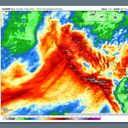"Dangerous" atmospheric river nears Central, Southern California

The strongest atmospheric river event of the season is set to begin Saturday night and early Sunday morning from north to south in California.
Threat level: The National Weather Service warned early Saturday that confidence is high that "life-threatening flooding" would occur even in heavily populated areas of L.A. County.
- The storm will bring a swath of 3-to-6-inch-plus rainfall totals, with locally heavier amounts, from Monterrey southward to Los Angeles, with slightly lower amounts south into San Diego.
- Downtown Los Angeles could see as much as 6 inches of rain in just 3 days based on current forecasts, with the potential for higher amounts.
Context: The city's average annual rainfall is about 14 inches.
- Several feet of snow are likely to fall in the Sierra Nevada Mountains, perhaps enough to block access to some communities.
- The National Weather Service forecast offices in Los Angeles and the Bay Area are calling the storm's likely impacts "very dangerous."
- They noted that flash flooding and river flooding will occur quickly on Sunday into Monday, given that the ground is already saturated from recent rains.
What they're saying: "Flooding issues will not be confined to just the foothills, mountains, and burn areas," the NWS LA said in an online forecast discussion Saturday morning.
- "ALL AREAS, INCLUDING HIGHLY POPULATED URBAN AREAS, WILL BE AT RISK FOR LIFE THREATENING FLOODING."
- "Streams and small rivers, as well as the Los Angeles River through the San Fernando Valley and metro LA will rise quickly and turn into very dangerous raging rivers," the NWS forecasters stated.
- "Many roads will be impassable due to flooding."
What we're watching: Forecasters also warned of "numerous" mudslides in areas with steeper slopes and of the likely need for evacuations.
- These impacts have claimed lives in past atmospheric river events in this region.
Zoom in: The east-to-west oriented mountains in Southern California, known as the Transverse Ranges could pick up 10 to 12 inches of rain as a firehose of tropical moisture is directed at them from the southwest.
- This could affect Santa Barbara, Ventura and Los Angeles counties, among others.
- This storm is also likely to have higher winds than other atmospheric rivers so far this winter.
How it works: This is due to a rapidly intensifying area of low pressure moving close to the Central California coastline.
- The Bay Area will be among the first areas to be buffeted by winds up to 70 mph, with higher gusts in hills and mountains.
- Such winds will also batter Southern California, leading to lengthy air travel delays and power outages.
Details: The storm will tap into a strong atmospheric river, which is a narrow highway of moisture at mid-levels of the atmosphere, and aim it at the California coast for a prolonged period.
- This air will contain a tremendous amount of water vapor, which will be enhanced by unusually high sea surface temperatures.
- "The warmer the surface ocean is, the more potential evaporation there is off of it," said UCLA climate scientist Daniel Swain.
- He said human-caused climate change plus El Niño are likely causing this year's trend.
Zoom out: Human-caused climate change is making extreme precipitation events more common and intense across the U.S. and worldwide and is predicted to make atmospheric rivers even wetter in coming years.
- One 2022 study found that atmospheric rivers that hit California in 2017 were made up to 15% wetter due to human-caused climate change, suggesting such an influence may already be detectable.
Of note: 9.1 million people, including those in areas of LA County, are under a "moderate risk" for excessive rainfall Sunday, with 16.5 million under such a risk on Monday.
- It is rare to have a moderate risk outlook, the second highest on the scale, issued well in advance for a large U.S. city, and is indicative of the level of forecast confidence that flooding will occur.
The bottom line: This storm will be a high-impact event for tens of millions in California, with an array of life-threatening hazards.
Editor's note: This article has been updated with new forecast details.